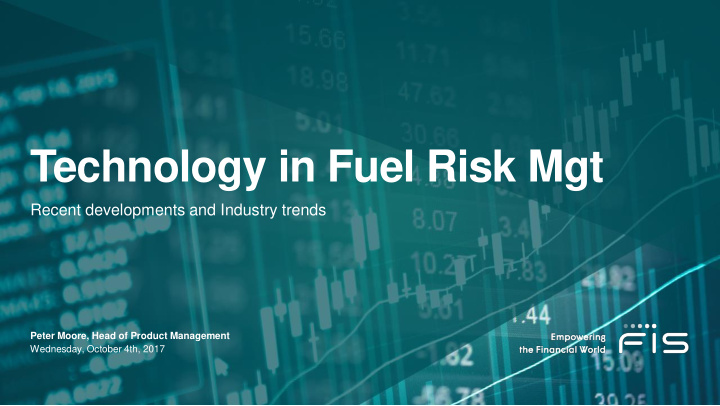



Technology in Fuel Risk Mgt Recent developments and Industry trends Peter Moore, Head of Product Management Wednesday, October 4th, 2017
Cyber Attacks
3
Is there safety in the Cloud? 4
How does the Cloud work? 5
Other benefits of Cloud Computing • Global Access • Lower Total Cost of Ownership • Faster time to market • Simpler, quicker upgrades • Scalability 6
Takeup of Cloud Technology 2011 IBM Survey of Business & Technology Leaders: 7
Takeup of Cloud technology 2017 Energy Risk Survey on Cloud usage in Energy/Commodities: • 64% would like to deploy more to cloud in future 8
Other Technology Developments in CTRM • More analytics employed in hedge strategy • More automation and integration between systems • Greater attention paid to credit risk • Concern over potential impact of regulatory developments 9
Cash Flow at Risk • A probability based measure of worst case cost of commodity purchases • Takes into account market characteristics • Enables a rigorous, quantitative approach to analysing effect of hedge strategies • Enables risk based approach to dynamic hedging 10
Illustration: buy 100k MT Jet NWE for next 2 years • As of end Sept 2017, market was pricing a 24 month swap to Dec 19 at $551/MT • Implies spend on Jet fuel of $1.3bn • Market implied volatility ~30% • Implies 1/20 probability cost > $1.9bn, conversely 1/20 probability cost < $880 MM • Alternatively, implies worst case fuel price $805, best case $367 11
What happened when volatility was higher? • In Feb 2017, market implied volatility was ~55% • Market price for 24 month swap was $409, implying cost of $908 MM • 95% CFaR = $1.6bn, 5% CFaR = $550 MM • Implied prices of $683 @95%, $230 @5% 12
What does a Jet Swap hedge do to CFaR? • Hedge 50% of exposure at market rate • 95% CFaR = $1.6bn, 5% = $1.1bn • Implied fuel price @95% = $683, 5% = $463 • => implied best to worst range of $219 13
What about hedging with Brent? • Same effective hedge % with Brent swap = 394,000 bbl/mth • 95% CFaR = $1.7bn, 5% = $1bn • Implies 95% price of $714, 5% price of $427 • Effective best to worst range of $288 14
Credit Risk • Airline counterparties have evolved measurement of credit risk: • Notional Exposure • MTM • VaR • CFaR • PFE • CVA • This affects your credit utilisation • Can you verify the counterparty’s calculations? 15
Regulatory developments EMIR – Report all OTC trades to a Trade Repository; mandatory clearing of trades if gross positions > EUR 3bn… Under Review MIFID 2 – position limits, trade reporting, best execution. CRD IV – capital requirements for commodity dealers – delayed to Dec 2020 IFRS 9 – changes to hedge accounting standards 16
Dealing with regulatory changes Practicalities behind monitoring and reporting How people, technology and processes can help address the reporting requirements more effectively PROCESSES PEOPLE TECHNOLOGY
Questions and Answers
Thank you Peter Moore Product Manager – Kiodex Risk & Compliance T : (+44) 208 081 2639 C : (+44) 7785 753409 E : peter.j.moore@fisglobal.com For more information, email us at getinfo@fisglobal.com or visit www.fisglobal.com/energy
Recommend
More recommend